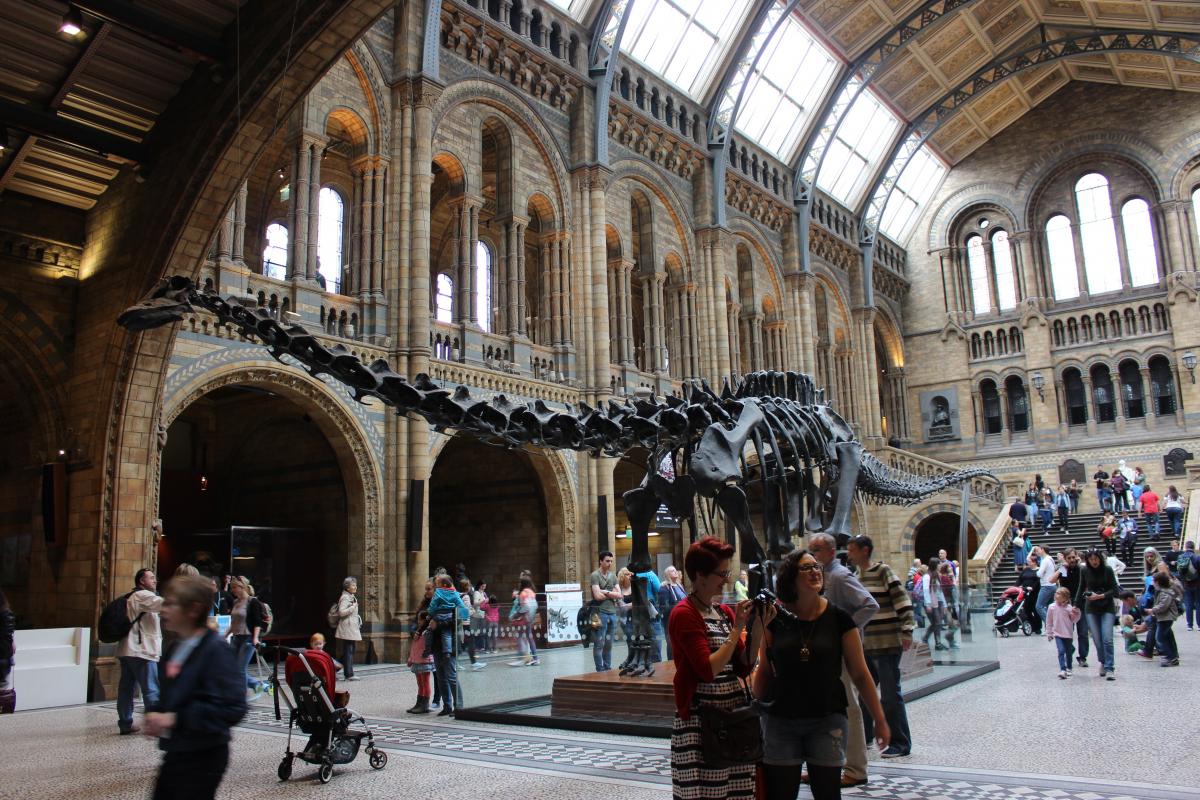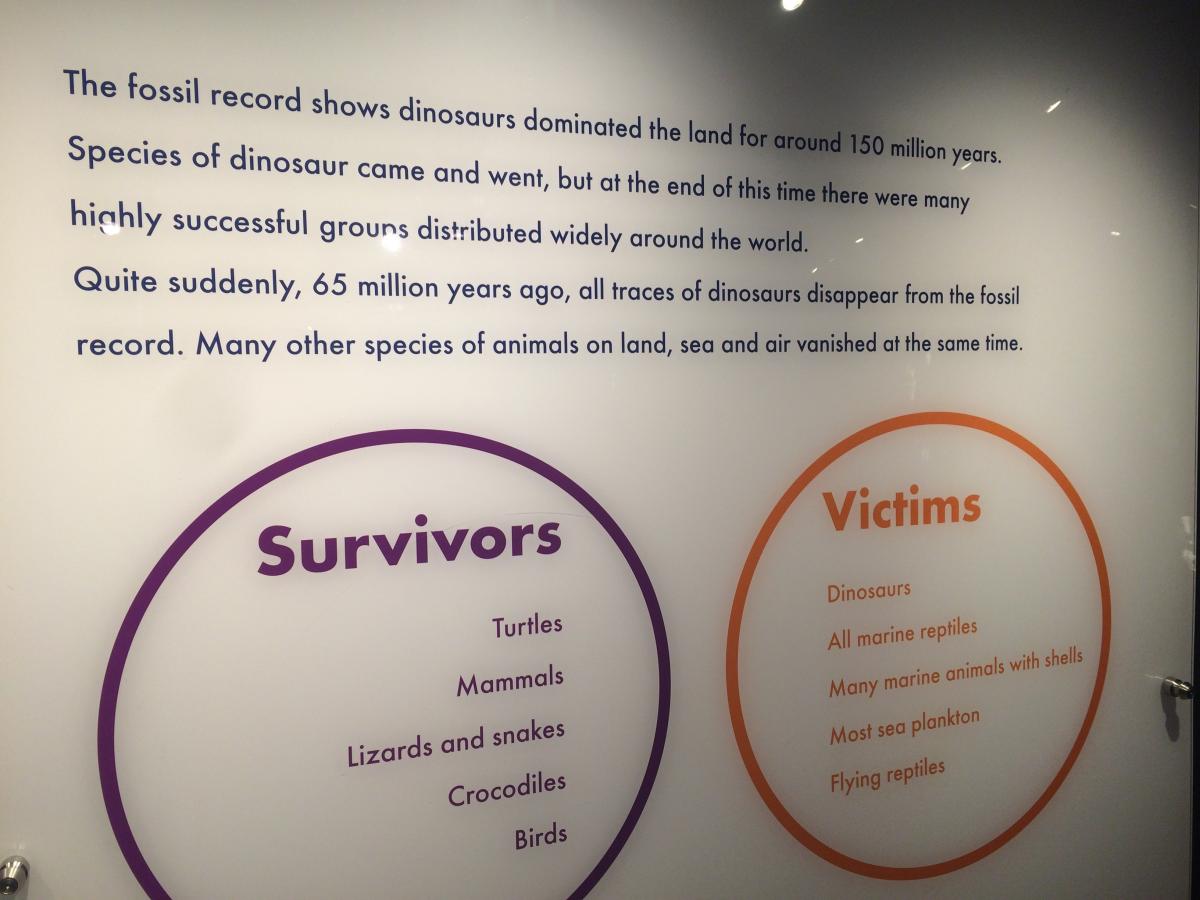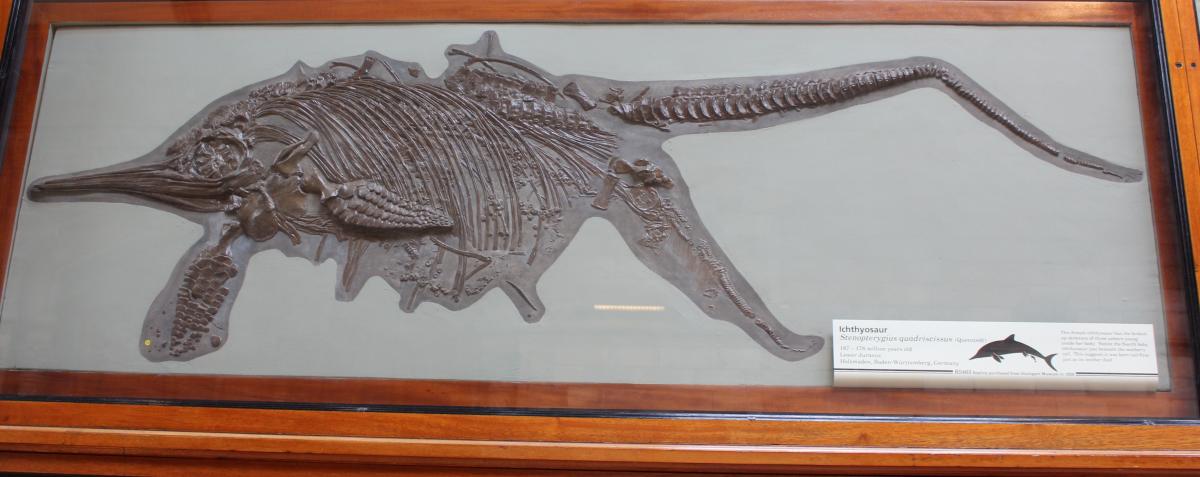 Let me start this post with this declaration: the Natural History Museum in Knightbridge, London, is awesome. Where else does a marble statue of Darwin sit serenely atop a grand staircase overlooking “Dippy,” a magnificent Diplodocus? Nowhere. (I bet that NHM is glad that it’s a Diplodocus and not an Apatosaur/Brontosaur—they dodged a nomeclatural bullet there!) My visit to the museum (and I only had time to visit about one-third of the displays!) made me downright giddy many times. From the wall of stunning marine reptiles (not dinosaurs, thank you!), most found along England’s south coast, to the life-size blue whale that literally and figuratively dwarfs all around it, the place is a gem.
Let me start this post with this declaration: the Natural History Museum in Knightbridge, London, is awesome. Where else does a marble statue of Darwin sit serenely atop a grand staircase overlooking “Dippy,” a magnificent Diplodocus? Nowhere. (I bet that NHM is glad that it’s a Diplodocus and not an Apatosaur/Brontosaur—they dodged a nomeclatural bullet there!) My visit to the museum (and I only had time to visit about one-third of the displays!) made me downright giddy many times. From the wall of stunning marine reptiles (not dinosaurs, thank you!), most found along England’s south coast, to the life-size blue whale that literally and figuratively dwarfs all around it, the place is a gem.
However.
I’d like to humbly suggest a few edits to some signs. If you follow me on Twitter (@keeps3), you know that I came across a few displays that made me go “hmmmmm…” and not in a good, “ooh, that’s thought-provoking!” kind of way. Part of me hates to call attention to these—shall we say iffy?—failures in the signage, because, again: NHM is amazing. I do not at all want to suggest that it’s a poor museum or in any way trying to subvert science.
However.
I think that in a few places there is room for improvement.
 Exhibit A: At the end of the dinosaur hall, in which you are funneled up and around a large hall full of both familiar and not-so-familiar dinosaurs, there is a sign on extinction that says: “Quite suddenly, 65 million years ago, all traces of dinosaurs disappeared from the fossil record. Many other species of animals on land, sea and air disappeared at the same time.” Then, there are two large circles that list “Victims,” including dinosaurs, marine reptiles, and flying reptiles, and “Survivors,” including turtles, mammals, and birds.
Exhibit A: At the end of the dinosaur hall, in which you are funneled up and around a large hall full of both familiar and not-so-familiar dinosaurs, there is a sign on extinction that says: “Quite suddenly, 65 million years ago, all traces of dinosaurs disappeared from the fossil record. Many other species of animals on land, sea and air disappeared at the same time.” Then, there are two large circles that list “Victims,” including dinosaurs, marine reptiles, and flying reptiles, and “Survivors,” including turtles, mammals, and birds.
Huh? Birds are dinosaurs. Yet there wasn’t even a hint of this fact, known to every ten-year-old, in the signage. This seems an even odder oversight when the signage was so careful to make sure that we know flying reptiles and marine reptiles aren’t dinosaurs. (The staff is paying attention, by the way. There is a pteranodon over the coat room and I was telling my daughter about it, and the man checking our bags thanked me for not calling it a dinosaur—it’s a pet peeve of his, he said. We bonded immediately.) I started grumbling about this to my mother-in-law, who replied, “Well, maybe they’re just trying to use the common terms and figure most people don’t know that birds are dinosaurs,” to which I answered, “But isn’t this where they are supposed to learn such things?” “Good point,” she admitted. If I could edit the sign, I’d make a simple parenthetical addition to the Victims circle: “Dinosaurs (except birds).”
 Exhibit B was also found in the dinosaur hall. The lower hall has some wonderful information on dinosaur anatomy and physiology. How do we know how fast dinosaurs grew (bone growth rings!)? How do we know how long they lived (we suspect some got pretty old because they got arthritis!)? That kind of thing. But then there was a display on dinosaur posture that explained that there are three general stances found in the animal kingdom: arms and legs extended out from the hips and shoulders with the belly low to the ground; arms and legs still held away from the body, but somewhat tucked under and held a bit straighter, lifting the animal up off the ground a little; arms and legs oriented right under hips and shoulders and more or less perpendicular to the ground. Picture an iguana, a crocodile, and a dinosaur. I have always heard these three general categories described as sprawling, semi-erect, and erect. This sign, however, used the terms sprawling, semi-improved, and fully improved.
Exhibit B was also found in the dinosaur hall. The lower hall has some wonderful information on dinosaur anatomy and physiology. How do we know how fast dinosaurs grew (bone growth rings!)? How do we know how long they lived (we suspect some got pretty old because they got arthritis!)? That kind of thing. But then there was a display on dinosaur posture that explained that there are three general stances found in the animal kingdom: arms and legs extended out from the hips and shoulders with the belly low to the ground; arms and legs still held away from the body, but somewhat tucked under and held a bit straighter, lifting the animal up off the ground a little; arms and legs oriented right under hips and shoulders and more or less perpendicular to the ground. Picture an iguana, a crocodile, and a dinosaur. I have always heard these three general categories described as sprawling, semi-erect, and erect. This sign, however, used the terms sprawling, semi-improved, and fully improved.
Huh? Improved? Doesn’t that imply a rather ladder-of-life arrangement and a rather progression-toward-perfection way of looking at things? Is a dinosaur an improvement on an iguana? I don’t think so. So why use terms that suggest it is? Now, my friend Corwin Sullivan (co-describer of the batwinged dino-pigeon Yi qi) told me that the origin of these terms can be traced back to a 1972 book chapter by English paleontologist Alan Charig. Charig spent his career at the Natural History Museum, London. However, NHM London is going against the norm by continuing to use Charig's terminology. Another paleontologist, Robert Bakker, also wrote about postural evolution in the early 1970s, and his terms—"sprawling", "semierect," and "erect"—were the ones adopted in almost all subsequent studies—with good reason. Not only do these terms avoid an evolutionary misconception, but there is no evidence that upright posture is in any way more efficient than a sprawling posture. So, unsurprisingly, if I could edit the sign, I’d go to the standard—and not misleading—“semi-erect” and “fully erect” terminology.
 And then Exhibit C. I nearly missed a small sign at the tail end of the “Restless Surface” exhibit on weather and the rock cycle—and we were hurrying at this point because we were in charge of a crew of increasingly impatient toddlers. But it caught my eye because its title was “Global warming?” and I thought to myself…question mark? So I read the text underneath and it said, under a subheading, “But is this cause and effect?”: “We know enough to be seriously concerned. But there is no easy answer. We simply do not understand enough about our planet’s regulatory mechanisms to be sure.”
And then Exhibit C. I nearly missed a small sign at the tail end of the “Restless Surface” exhibit on weather and the rock cycle—and we were hurrying at this point because we were in charge of a crew of increasingly impatient toddlers. But it caught my eye because its title was “Global warming?” and I thought to myself…question mark? So I read the text underneath and it said, under a subheading, “But is this cause and effect?”: “We know enough to be seriously concerned. But there is no easy answer. We simply do not understand enough about our planet’s regulatory mechanisms to be sure.”
On the contrary, judging from 97.1% of the relevant scientific research papers, we do understand enough. I understand that the NHM doesn’t want to scare the children who have just been playing with stream tables and spinning a giant rock cycle—but we do understand enough, and to suggest we don’t is a disservice to these children who are going to inherit the mess we have made (climate change is a children’s issue, after all). If I could edit the sign, I’d say, “Yes, the vast majority of scientists agree that there is a definite link between human behavior and changes to the global climate. The good news? Humanity has a history of overcoming enormous challenges, and a lot of smart people are working toward solutions. Will you join them one day?”
 So what do you think, friends? Am I overreacting, or being too harsh on the museum? I don’t think so, but I’d like your thoughts. And if anyone knows someone at the NHM in London, let me know—maybe we can get some signs edited…
So what do you think, friends? Am I overreacting, or being too harsh on the museum? I don’t think so, but I’d like your thoughts. And if anyone knows someone at the NHM in London, let me know—maybe we can get some signs edited…
Are you a teacher and want to tell us about an amazing free resource? Do you have an idea for a future Misconception Monday or other post? See some good or bad examples of science communication lately? Drop me an email or shoot me a tweet @keeps3.

